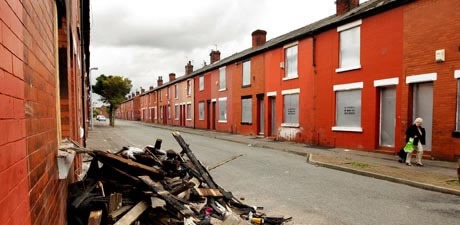Figures according to the Census

In contrast, only one in twelve of the Census’s White British group lived in deprived neighbourhoods.
Dr Stephen Jivraj from The University of Manchester and Dr Omar Khan from the Runnymede Trust say all ethnic minority groups are more likely to live in deprived neighbourhoods than the White British majority.
The non-white ethnic groups have unemployment rates in deprived and other neighbourhoods which are double that of white groups, suggesting they face employment disadvantage wherever they live.
Also according to the researchers, ethnic inequalities of neighbourhood deprivation vary by region: they are greatest in the Midlands and smallest in the South.
Almost half of the Pakistani group in the Midlands and North lived in a deprived neighbourhood, compared with only 4 and 8 percent of those living in the South and London, respectively.
The Other Black, African and Caribbean ethnic groups all have figures of more than one in five according to the Joseph Rowntree Foundation funded briefing – now available online on the University’s Centre on Dynamics of Ethnicity (CoDE) website.
A further analysis of the Index of Multiple Deprivation 2010 (IMD 2010), reveals a fascinating picture on its indicators of income, employment, health, education, barriers to housing and services, crime, and living environment.
Dr Jivraj, who is based at CoDE, said: “Our research shows that the Bangladeshi ethnic group was the most likely to live in deprived neighbourhoods because of low income in 46% of cases, and barriers to housing and services in 32%.
“The Pakistani ethnic group was the most likely to live in deprived neighbourhoods because of poor living environment in 39% of cases, education, 23%, health, 20% and employment, 16%.
He added: “The labour market inequalities we highlight are compounded by disadvantages in education, health and housing.
“Moreover, the concentration of ethnic minorities in the poorest parts of the country may further restrict their employment opportunity in what can be described as a ‘double disadvantage’.”
Though the disparity is stark, the researchers also find a substantial reduction in the proportion of the Bangladeshi and Pakistani groups that live in a deprived neighbourhood since 2001.
The cause though, they say, is a higher rate of population growth in less deprived neighbourhoods compared with the most deprived neighbourhoods.
Also, say the researchers, mixed and Black ethnic groups had considerably higher rates of unemployment than the White British group within the most deprived and better-off neighbourhoods.
Omar Khan said: “Our analysis shows that where people live affects ethnic groups differently. However, some groups are more likely to be disadvantaged wherever they live. For example, Mixed and Black ethnic groups face similar levels of employment disadvantage, whether they live in a deprived neighbourhood or better-off neighbourhoods.
“However, 10% of Asians in better-off neighbourhoods were unemployed compared with 6% for the White British population. In contrast, Asian people in deprived neighbourhoods are no more likely to be unemployed than White British people (both at 17%). This suggests that Asian people living in better off neighbourhoods do not benefit as much as white people living in those areas in terms of employment opportunities.”



































